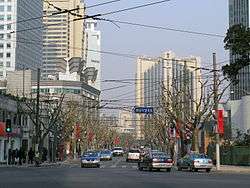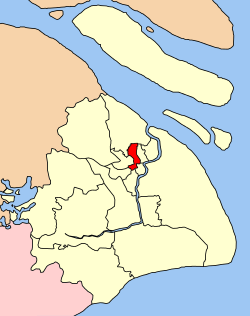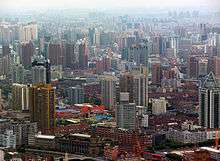Jing'an District
| Jing'an 静安区 | |
|---|---|
| District | |
 | |
 Location within Shanghai | |
| Area | |
| • Total | 37.37 km2 (14.43 sq mi) |
| Population (2015) | 1,000,000 |
| • Density | 27,000/km2 (69,000/sq mi) |
| Area Code | 021 |
| Postal Code | 200040-200042(Former Jing'an) 200070-200073 200085 200435-2000436 200443(Former Zhabei) |
| Website | http://www.jingan.gov.cn/ |
| Jing'an District | |||||||||||
| Simplified Chinese | 静安区 | ||||||||||
|---|---|---|---|---|---|---|---|---|---|---|---|
| Traditional Chinese | 靜安區 | ||||||||||
| |||||||||||
Jing'an District, is one of the central districts of Shanghai. It has an area of 37 km². With 1,180,000 inhabitants (in 2014).[1][2]
The district borders the Hongkou District to the east, Huangpu District to the east and south, Putuo District to the east, Baoshan District to the north and Changning District to the west.
On 4 November 2015, Zhabei District merged with Jing'an District bringing Shanghai down to 15 districts and one county.[3][4]
Jing'an District was named after Jing'an Temple, an ancient traditional Chinese Buddhist temple, today's temple is a new replica of the old one, located in the southern part of the district. An Art Deco "dancehall" is just across the street; around the neighborhood are bar streets, although some areas develop and other close through the years. Jing'an Park, located opposite to the temple, is quite popular among locals; it used to be a graveyard for foreigners in the old Shanghai.
Historically, the northern part of the district, what used to be Zhabei, has been highly populated with working class residents. However, due to the shift in the structure of industries and increasing number of immigrants from outside Shanghai, partly due to its reasonable real estate price (compared to its counterparts such as Putuo and Hongkou), the district has become increasingly appealing to city residents.

Economy and Facilities
Development in the southern part of the district has been rapid and continuous. In just three years the complete stock of Grade A Office Space in the southern part of the district has increased approximately 320 percent, from a total of just 333,000 sqm in 2007 to 1,067,000 sqm in 2010. West Nanjing Road is one of Shanghai's premier shopping districts, and is home to five-star hotels and exhibition centers as well as several upscale housing complexes.[5] Key landmarks on West Nanjing Road include the Shanghai Exhibition Centre and the Shanghai Centre.
The southern part of the district is one of Shanghai's key central business and commercial districts. It contains numerous large office buildings, hotels, and many shopping venues at the street level. The district comprises a prominent portion of the Shanghai skyline. The district is also known for having many high-rise residential buildings.[6]
The northern part of the district used to be the place of agglomeration of traditional industries such as flavor factory and tires factory. In the last decade, the municipality decided to move the old industry out in order to make space for more promising ones such as the hi-tech and creative industries. It has attracted various foreign companies to build offices, apartments and commercial retail outlets over there.
It is also where the Shanghai Multimedia Valley (SMV) is located to attract media and IT talent. Major companies located in Zhabei include TÜV Rheinland, Royal Philips Electronics and Shanghai Bell Alcatel Business Systems Co., LTD.[7]
China Resources Beverage, the distributor of C'estbon water, has its east China regional office on the twentieth floor of the Huanzhi International Building (环智国际大厦) in the district.[8]
Daning Lingshi Park, the biggest green area in the downtown area, is surrounded [9] by a series of cultural facilities such as the Zhabei Stadium and Shanghai Circus World.
The Shanghai University, Yanchang Campus is also located near the Daning Lingshi Park.
Subdistricts and Towns
| Name | Chinese (S) | Hanyu Pinyin | Shanghainese Romanization | Population (2010)[10] | Area (km2) |
|---|---|---|---|---|---|
| Beizhan Subdistrict[11] | 北站街道 | Běizhàn Jiēdào | poq dze ka do | 77,968 | 1.99 |
| Baoshan Road Subdistrict | 宝山路街道 | Bǎoshānlù Jiēdào | po se lu ka do | 80,726 | 1.62 |
| Caojiadu Subdistrict[12] | 曹家渡街道 | Cáojiādù Jiēdào | dzo ka du ka do | 71,511 | 1.50 |
| Daning Road Subdistrict | 大宁路街道 | Dànínglù Jiēdào | da gnin lu ka do | 77,710 | 6.24 |
| Gonghexin Road Subdistrict | 共和新路街道 | Gònghéxīnlù Jiēdào | gon wu sin lu ka do | 97,630 | 2.72 |
| Jiangning Road Subdistrict | 江宁路街道 | Jiāngnínglù Jiēdào | kaon gnin lu ka do | 75,272 | 1.84 |
| Jing'ansi Subdistrict | 静安寺街道 | Jìng'ānsì Jiēdào | dzin eu zy ka do | 29,173 | 1.57 |
| Linfen Road Subdistrict | 临汾路街道 | Línfénlù Jiēdào | lin ven lu ka do | 78,079 | 2.12 |
| Pengpu Town | 彭浦镇 | Péngpǔ Zhèn | ban phu tzen | 152,725 | 7.88 |
| Pengpu Xincun Subdistrict | 彭浦新村街道 | Péngpǔ Xīncūn Jiēdào | ban phu sin tsen ka do | 156,276 | 3.83 |
| Shimen Second Road Subdistrict | 石门二路街道 | Shímén Èrlù Jiēdào | zaq men gnij lu ka do | 34,288 | 1.09 |
| West Nanjing Road Subdistrict | 南京西路街道 | Nánjīng Xīlù Jiēdào | neu cin sij lu ka do | 36,544 | 1.62 |
| West Tianmu Road Subdistrict | 天目西路街道 | Tiānmù Xīlù Jiēdào | thi moq sij lu ka do | 34,749 | 1.94 |
| West Zhijiang Road Subdistrict | 芷江西路街道 | Zhǐjiāng Xīlù Jiēdào | tzy kaon sij lu ka do | 74,633 | 1.60 |
Transportation
Metro
Jing'an is currently served by seven metro lines operated by Shanghai Metro:
- Line 1 - Hanzhong Road, Shanghai Railway Station 3 4 , North Zhongshan Road, Yanchang Road, Shanghai Circus World, Wenshui Road, Pengpu Xincun, Gongkang Road
- Line 2 - Jing'an Temple 7 , West Nanjing Road
- Line 3 and Line 4 - Shanghai Railway Station 1 , Baoshan Road
- Line 7 - Changping Road Station, Jing'an Temple 2
- Line 8 - North Xizang Road, Zhongxing Road, Qufu Road 12
- Line 10 - Tiantong Road 12
- Line 12 - Hanzhong Road 1 13 , West Nanjing Road 2 13 , Qufu Road 8 , Tiantong Road 10
- Line 13 - Hanzhong Road 1 12 , Natural History Museum, West Nanjing Road 2 12
See also
References
- ↑ http://www.shanghaidaily.com/metro/public-services/Shanghai-merges-downtown-Jingan-with-Zhabei-District/shdaily.shtml
- ↑ http://www.shanghaidaily.com/metro/society/Jingan-Zhabei-merge-to-create-engine-for-Shanghais-growth/shdaily.shtml
- ↑ "上海闸北区、静安区正式合并 成立新静安区". thepaper.cn. November 4, 2015. Retrieved November 4, 2015.
- ↑ http://www.shanghaidaily.com/metro/society/Jingan-Zhabei-merge-to-create-engine-for-Shanghais-growth/shdaily.shtml
- ↑ Knight Frank China, Knight Frank China, Shanghai Research, Greater China Report 2009
- ↑ "Shanghai Jing'An District". movingcities.org. January 20, 2010.
- ↑ "A Survey about Zhabei District". Zhabei authority. Retrieved 2010-11-02.
- ↑ "Contact 联系我们." China Resources Beverage. Retrieved on April 10, 2014. "华东分公司 地址: 上海市恒丰路436号环智国际大厦20楼"
- ↑ Shanghai Zhabei Government Portal - www.shzb.gov.cn/en
- ↑ shi, Guo wu yuan ren kou pu cha ban gong; council, Guo jia tong ji ju ren kou he jiu ye tong ji si bian = Tabulation on the 2010 population census of the people's republic of China by township / compiled by Population census office under the state; population, Department of; statistics, employment statistics national bureau of (2012). Zhongguo 2010 nian ren kou pu cha fen xiang, zhen, jie dao zi liao (Di 1 ban. ed.). Beijing Shi: Zhongguo tong ji chu ban she. ISBN 978-7-5037-6660-2.
- ↑ "闸北区-行政区划网 www.xzqh.org" (in Chinese). XZQH. Retrieved 2012-05-24.
- ↑ "静安区-行政区划网 www.xzqh.org" (in Chinese). XZQH. Retrieved 2012-05-24.
Further reading
- "Jing'an District". Encyclopedia of Shanghai. Shanghai Municipal Government. 2010.
External links
| Wikimedia Commons has media related to Jing'an District. |
 Jing'an District travel guide from Wikivoyage
Jing'an District travel guide from Wikivoyage- Jing'an District website (Chinese)
- Jing'an District website (English version)
-
 Zhabei District travel guide from Wikivoyage
Zhabei District travel guide from Wikivoyage - Shanghai Zhabei Government Portal
- Shanghai Circus World
Coordinates: 31°13′53″N 121°27′11″E / 31.2314°N 121.453°E
